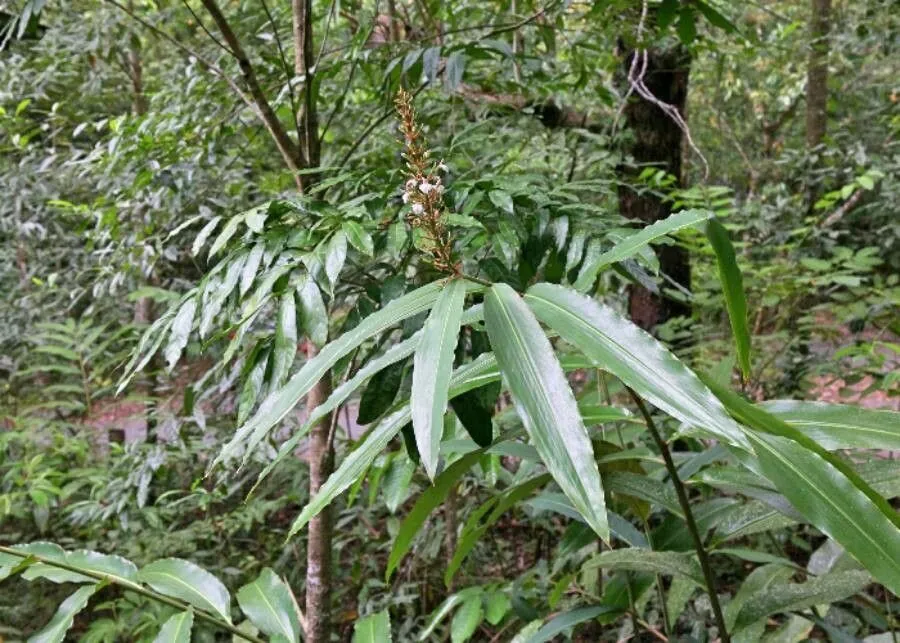
Author: (R.Br.) Benth.
Bibliography: Fl. Austral. 6: 265 (1873)
Year: 1873
Status: accepted
Rank: species
Genus: Alpinia
Vegetable: False
Observations: Papua New Guinea, E. Queensland to NE. New South Wales
The Blue Berry Ginger, scientifically known as Alpinia caerulea, is a vibrant and robust member of the Zingiberaceae family. This distinctive plant was first documented in the Flora Australiensis, Volume 6, on page 265 in 1873, as described by the renowned botanist George Bentham, building on the initial classification by Robert Brown.
Native to the tropical and subtropical regions of Papua New Guinea and Eastern Australia, specifically spanning from Eastern Queensland down to Northeast New South Wales, the Blue Berry Ginger thrives in the lush, humid environments characteristic of these areas. Its natural habitat includes rainforests and moist, sheltered locations, which provide the ideal conditions for its growth.
The striking appearance of the Blue Berry Ginger makes it easily recognizable. Its large, lance-shaped leaves, which can reach impressive lengths, form a dense, bushy clump. Most notably, it produces eye-catching, bright blue berries that contrast beautifully with its green foliage. These berries are not only visually appealing but are also edible, adding a unique and exotic flavor to various culinary dishes.
The plant’s inflorescence is also quite remarkable, featuring clusters of tubular, creamy white flowers that bloom throughout the warmer months. These flowers attract a variety of pollinators, including bees and butterflies, thus playing a crucial role in the local ecosystem’s biodiversity.
In addition to its ornamental value, Alpinia caerulea has cultural and practical significance. Traditionally, indigenous Australians have utilized different parts of the plant for medicinal and dietary purposes. The rhizomes of the Blue Berry Ginger, in particular, have been used for their aromatic properties and potential health benefits.
Cultivating Blue Berry Ginger can be highly rewarding for gardeners seeking a resilient and decorative plant. It prefers well-drained, slightly acidic to neutral soil and thrives with regular watering, mimicking its natural rainforest environment. While it can tolerate short periods of drought, its growth is optimal in consistently moist conditions with partial to full shade.
In summary, Alpinia caerulea, or Blue Berry Ginger, is a visually stunning and ecologically important plant, deeply rooted in the rich flora of Papua New Guinea and Eastern Australia. Its combination of aesthetic appeal, edible fruit, and traditional uses make it a remarkable species within the Zingiberaceae family.
En: Blue Berry Ginger, Native Ginger
Taken Jul 28, 2022 by Michal Svit (cc-by-sa)
Taken Apr 4, 2022 by Allison Kaj (cc-by-sa)
Taken Jun 20, 2020 by Gerard Sadaya (cc-by-sa)
Taken Oct 25, 2015 by Sébastien TRASBOT (cc-by-sa)
Taken Oct 25, 2015 by Sébastien TRASBOT (cc-by-sa)
Taken Oct 25, 2015 by Sébastien TRASBOT (cc-by-sa)
Taken Feb 17, 2007 by Sébastien TRASBOT (cc-by-sa)
Taken Feb 17, 2007 by Sébastien TRASBOT (cc-by-sa)
Taken Apr 4, 2022 by Allison Kaj (cc-by-sa)
Taken Apr 4, 2022 by Allison Kaj (cc-by-sa)
Taken Feb 17, 2007 by Sébastien TRASBOT (cc-by-sa)
Taken Feb 17, 2007 by Sébastien TRASBOT (cc-by-sa)
Sowing: Direct seed, rhizomes
Family: Myrtaceae Author: (F.Muell.) K.D.Hill & L.A.S.Johnson Bibliography: Telopea 6: 402 (1995) Year: 1995 Status:…
Family: Rubiaceae Author: Pierre ex A.Froehner Bibliography: Notizbl. Bot. Gart. Berlin-Dahlem 1: 237 (1897) Year:…
Family: Sapindaceae Author: Koidz. Bibliography: J. Coll. Sci. Imp. Univ. Tokyo 32(1): 38 (1911) Year:…
Family: Asteraceae Author: A.Gray Bibliography: Pacif. Railr. Rep.: 107 (1857) Year: 1857 Status: accepted Rank:…
Family: Fabaceae Author: Medik. Bibliography: Vorles. Churpfälz. Phys.-Ökon. Ges. 2: 398 (1787) Year: 1787 Status:…
Family: Aspleniaceae Author: (Cav.) Alston Bibliography: Bull. Misc. Inform. Kew 1932: 309 (1932) Year: 1932…